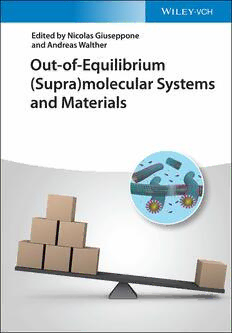
Out-of-Equilibrium (Supra)molecular Systems and Materials PDF
Preview Out-of-Equilibrium (Supra)molecular Systems and Materials
Out-of-Equilibrium(Supra)molecularSystemsandMaterials Out-of-Equilibrium (Supra)molecular Systems and Materials Edited by Nicolas Giuseppone Andreas Walther Editors AllbookspublishedbyWILEY-VCH arecarefullyproduced.Nevertheless, Prof.Dr.NicolasGiuseppone authors,editors,andpublisherdonot UniversityofStrasbourg warranttheinformationcontainedin DepartmentofChemistry thesebooks,includingthisbook,to InstitutCharlesSadron–CNRS befreeoferrors.Readersareadvised 23rueduLoess tokeepinmindthatstatements,data, 67034Strasbourg,Cedex2 illustrations,proceduraldetailsorother France itemsmayinadvertentlybeinaccurate. Prof.Dr.AndreasWalther LibraryofCongressCardNo.: UniversityofMainz appliedfor DepartmentofChemistry Duesbergweg10–14 BritishLibraryCataloguing-in-Publication 55128Mainz Data Germany Acataloguerecordforthisbookis availablefromtheBritishLibrary. CoverImage: ©Mediamodifier/58Bilder/Pixabay, Bibliographicinformationpublishedby (inset)courtesyofProf.SubiJ.George theDeutscheNationalbibliothek TheDeutscheNationalbibliotheklists thispublicationintheDeutsche Nationalbibliografie;detailed bibliographicdataareavailableonthe Internetat<http://dnb.d-nb.de>. ©2021WILEY-VCHGmbH,Boschstr. 12,69469Weinheim,Germany Allrightsreserved(includingthoseof translationintootherlanguages).No partofthisbookmaybereproducedin anyform–byphotoprinting, microfilm,oranyothermeans–nor transmittedortranslatedintoa machinelanguagewithoutwritten permissionfromthepublishers. Registerednames,trademarks,etc. usedinthisbook,evenwhennot specificallymarkedassuch,arenotto beconsideredunprotectedbylaw. PrintISBN:978-3-527-34615-8 ePDFISBN:978-3-527-82198-3 ePubISBN:978-3-527-82200-3 oBookISBN:978-3-527-82199-0 Typesetting SPiGlobal,Chennai,India PrintingandBinding Printedonacid-freepaper 10 9 8 7 6 5 4 3 2 1 v Contents Foreword xiii 1 Out-of-Equilibrium(Supra)molecularSystemsandMaterials: AnIntroduction 1 NicolasGiusepponeandAndreasWalther 1.1 GeneralDescriptionoftheField 1 1.1.1 Background,Motivation,andInterdisciplinaryNatureoftheTopic 1 1.1.2 FromEquilibriumSelf-AssemblytoFar-From-Equilibrium Self-Organization 5 1.1.3 FromResponsiveMaterialstoAdaptiveandInteractiveMaterials SystemswithLifelikeBehavior 7 1.1.4 AnOutlookonChallengesAhead 9 1.2 DescriptionoftheBookContent 10 Acknowledgments 14 References 14 2 LearningfromEmbryoDevelopmenttoEngineer Self-organizingMaterials 21 AnisSenoussi,YuliiaVyborna,HélèneBerthoumieux,Jean-ChristopheGalas, andAndréEstevez-Torres 2.1 TheEmbryoisaMaterialCapableofChemicalandMorphological Differentiation 22 2.2 PatternFormationbyaReaction–DiffusionTuringInstability 24 2.2.1 ShortMathematicalAnalysisoftheTuringInstabilityinaTwo-species System 26 2.2.2 TuringPatternsInVivo 27 2.2.3 TuringPatternsInVitro 28 2.2.4 SimplerthanTuring:Reaction–DiffusionWavesInVitro 29 2.2.4.1 MinProteinWaves 29 2.2.4.2 DNA/EnzymeWaves 31 2.3 PatternFormationbyPositionalInformation 32 2.3.1 ModelsofPositionalInformation 32 2.3.1.1 EquilibriumModel:Cooperativity 34 vi Contents 2.3.1.2 Reaction-onlyMechanism:TemporalBistability 34 2.3.1.3 Reaction–DiffusionMechanism:SpatialBistability 35 2.3.2 PositionalInformationInVivo:PatterningoftheDrosophila blastoderm 35 2.3.3 PositionalInformationInVitro 36 2.3.3.1 DNAStrandDisplacementPatterns 36 2.3.3.2 PENDNA/EnzymePatterns 38 2.3.3.3 Transcription–TranslationPatterns 39 2.4 ForceGenerationandMorphogenesisinReconstitutedCytoskeletal ActiveGels 40 2.4.1 CytoskeletalFilamentsandMolecularMotors,theBuildingBlocksof ActiveGels 41 2.4.2 ActiveGelTheoryfora1DSystem 42 2.4.3 ActiveStructuresGeneratedbyCytoskeletalSystemsInVitro 45 2.4.3.1 GlidingFilaments 45 2.4.3.2 AsterFormation 45 2.4.3.3 Contractions 46 2.4.3.4 ActiveFlows 46 2.4.3.5 Corrugations 47 2.4.3.6 VesicleandDropletDeformationandMovement 47 2.5 ConclusionandPerspectives 48 Acknowledgment 49 References 50 3 FromClockstoSynchrony:TheDesignofBioinspired Self-RegulationinChemicalSystems 61 AnnetteF.Taylor 3.1 Introduction 61 3.2 BioinspiredBehavior:InsightfromModels 62 3.3 FeedbackandClocks 63 3.3.1 ClockReactions 65 3.3.2 AutocatalysisinaClosedReactor 66 3.4 MaintainingSystemsFarfromEquilibrium 69 3.5 KineticSwitches 71 3.6 DesignofOscillators 72 3.7 WavesandPatterns 74 3.7.1 Fronts,Waves,andSpirals 74 3.7.2 StationaryConcentrationPatterns 76 3.8 SynchronizationandCollectiveBehavior 77 3.9 MaterialsSystems 78 3.9.1 CoupledReactionsandMaterials 78 3.9.2 FeedbackinPolymerizationandPrecipitationProcesses 79 3.10 Conclusions 81 References 82 Contents vii 4 DenovoDesignofChemicalReactionNetworksandOscillators andTheirRelationtoEmergentProperties 91 SergeyN.Semenov 4.1 Introduction 91 4.2 TheRoleofOut-of-EquilibriumConditionsintheEmergenceofCRN PropertiesandFunctions 94 4.3 TheRoleofStoichiometry,Connectivity,andKineticsforCRNs 96 4.4 DesignGuidelinesandNetworkMotifs 98 4.5 ExamplesofDenovoDesignedCRNsinWell-MixedSolutions 107 4.6 RecentAdvancesintheDesignofFlowSystems 112 4.7 ExamplesofDenovoDesignedReaction–DiffusionNetworks 112 4.8 AutocatalysisasanEmergentPropertyofCRNs 116 4.9 FutureChallengesandDirectionsinDesigningCRNs 119 References 120 5 KineticallyControlledSupramolecularPolymerization 131 KazunoriSugiyasu 5.1 Introduction 131 5.2 ThermodynamicModelsforSupramolecularPolymerization 134 5.3 SupramolecularPolymerizationUnderKineticControl 136 5.4 LivingSupramolecularPolymerization 139 5.5 SeededSupramolecularPolymerizationCoupledwithChemical Reactions 147 5.6 Equipment-ControlledSupramolecularPolymerizations 151 5.7 Crystallization-DrivenSelf-AssemblyandOtherSystems 153 5.8 Conclusion 157 References 158 6 ChemicallyFueled,TransientSupramolecularPolymers 165 MichelleP.vanderHelm,JanH.vanEsch,andRienkEelkema 6.1 Introduction 165 6.2 NonlinearBehavior:ALessonfromBiology 167 6.3 WalkingUphillintheEnergyLandscape 169 6.4 TheNatureoftheChemicalFuel 171 6.5 ChemicallyFueled,TransientSupramolecularPolymerization Systems 172 6.6 ConclusionandOutlook 184 References 185 7 DesignofChemicalFuel-DrivenSelf-AssemblyProcesses 191 KrishnenduDas,RuiChen,SushmithaChandrabhas,LucaGabrielli,and LeonardJ.Prins 7.1 Introduction 191 7.2 ChemicallyFueledSelf-Assembly 191 viii Contents 7.3 TransientSignalGenerationUsingGoldNanoparticles 197 7.4 Self-AssemblyUnderDissipativeConditions 199 7.5 Out-of-EquilibriumSelf-Assembly 201 7.6 TowardChemicalFuel-DrivenSelf-Assembly 205 7.7 Outlook 209 References 210 8 DynamicCombinatorialChemistryOutofEquilibrium 215 KaiLiuandSijbrenOtto 8.1 Introduction 215 8.2 KineticControlinDCC 217 8.2.1 IntroducingIrreversibleReactionsintoDCLs 217 8.2.1.1 IrreversibleReactionsActingonaSpecificLibraryMember 218 8.2.1.2 IrreversibleReactionsActingonMultipleDCLMembers 221 8.2.2 KineticallyTrappedSelf-AssemblyinDCC 223 8.2.3 PhaseChangesinDCC 225 8.2.4 DCCUnderNon-equilibriumConditions 228 8.3 DissipativeDCC 230 8.3.1 ChemicallyFueledDCC 231 8.3.2 Light-DrivenDCC 231 8.4 ConclusionsandOutlook 234 References 236 9 ControllingSelf-AssemblyofNanoparticlesUsingLight 241 TongBian,ZonglinChu,andRafalKlajn 9.1 Introduction 241 9.2 NanoparticleSurface-FunctionalizedwithPhotoswitchable Molecules 242 9.2.1 Azobenzene-FunctionalizedNanoparticles 242 9.2.2 Spiropyran-FunctionalizedNanoparticles 247 9.3 AssemblingNanoparticlesUsingPhotodimerizationReactions 251 9.4 (De)protonationofNanoparticle-BoundLigandsUsing Photoacids/Photobases 253 9.5 Light-InducedAdsorptionofPhotoswitchableMolecules 256 9.5.1 PhotoswitchableHost–GuestInclusionComplexesonNanoparticle Surfaces 256 9.5.2 NonselectiveAdsorptionofPhotoswitchableMolecules 259 9.6 PhaseTransitionsofThermoresponsivePolymersInducedbyPlasmonic Nanoparticles 261 9.7 Light-InducedChemicalReductionofNanoparticle-Bound Ligands 263 9.8 IrreversibleSelf-AssemblyofNanoparticles 265 9.9 ExtensiontoMicroparticles 266 9.10 SummaryandOutlook 268 References 269 Contents ix 10 PhotoswitchableComponentstoDriveMolecularSystems AwayfromGlobalThermodynamicMinimumbyLight 275 MichaelKathanandStefanHecht 10.1 Introduction 275 10.2 Thermodynamicvs.PhotodynamicEquilibria 277 10.3 ManipulatingChemicalReactionsandEquilibriawithLight 281 10.4 FromShiftingEquilibriatoContinuousWorkPoweredbyLight 287 10.5 LighttoControlAssemblyandCreateOrder 296 10.6 Conclusion:FromRemoteControllingtoDrivingProcesses 297 References 299 11 Out-of-EquilibriumThreadedandInterlockedMolecular Structures 305 MassimoBaroncini,AlbertoCredi,andSerenaSilvi 11.1 Introduction 305 11.1.1 Metastable,KineticallyTrapped,andDissipativeNon-equilibrium States 307 11.1.2 EnergyInputs 309 11.1.2.1 ChemicalEnergy 309 11.1.2.2 ElectricalEnergy 310 11.1.2.3 LightEnergy 310 11.1.3 MechanicallyInterlockedMoleculesandTheirThreaded Precursors 311 11.2 Pseudorotaxanes 312 11.2.1 Semirotaxane-BasedMolecularReservoirs 313 11.2.2 SupramolecularPumps 315 11.3 Rotaxanes 319 11.3.1 MolecularRatchets 319 11.3.2 GenerationofNon-equilibriumStatesbyAutonomousEnergy Consumption 322 11.4 Catenanes 324 11.4.1 MolecularSwitchesandEnergyRatchets 325 11.4.2 AutonomousChemicallyFueledCatenaneRotaryMotors 327 11.5 Conclusions 331 Acknowledgments 332 References 332 12 Light-drivenRotaryMolecularMotorsforOut-of-Equilibrium Systems 337 AnoukS.Lubbe,CosimaL.G.Stähler,andBenL.Feringa 12.1 Introduction 337 12.2 DesignandSynthesisofLight-drivenRotaryMotors 339 12.3 TuningthePropertiesofMolecularMotors 342 12.4 MolecularMotorsasOut-of-EquilibriumSystems 346 12.5 SingleMoleculesGeneratingWorkontheNanoscale 348 x Contents 12.5.1 MolecularStirring 349 12.5.2 AmplifyingMotorFunction 350 12.6 Immobilization 352 12.6.1 Surface-AttachedMolecularMotors 352 12.6.2 3DNetworks 355 12.7 LiquidCrystalsandPolymerDoping 358 12.7.1 LiquidCrystals 358 12.7.2 PolymerDoping 361 12.8 Self-assembledSystems 364 12.9 Conclusion 368 References 369 13 DesignofActiveNanosystemsIncorporatingBiomolecular Motors 379 StanislavTsitkovandHenryHess 13.1 Introduction 379 13.2 ActiveNanosystemDesign 381 13.3 BiologicalComponentsofActiveNanosystems 384 13.3.1 Microtubules 385 13.3.2 Kinesin 387 13.3.3 Dynein 388 13.3.4 ActinFilaments 388 13.3.5 Myosin 389 13.4 InteractionsBetweenComponentsofActiveNanosystems 389 13.4.1 FilamentResponsetoExternalLoad 390 13.4.2 Motor–FilamentInteractions 390 13.4.3 Filament–FilamentInteractions 392 13.4.4 Filament–CargoInteractions 392 13.4.5 Motor–SurfaceInteractions 393 13.5 ImplementationsofActiveNanosystems 393 13.5.1 DeliveringCargoinActiveNanosystems 394 13.5.2 SensingUsingActiveNanosystems 396 13.5.2.1 Biosensors 396 13.5.2.2 SurfaceCharacterization 396 13.5.2.3 ForceMeasurements 397 13.5.3 ControllingtheBehaviorofActiveNanosystems 397 13.5.3.1 PassiveControl 397 13.5.3.2 ActiveControl 398 13.5.4 ExtendingtheLifetimeofActiveNanosystems 398 13.5.5 Higher-OrderStructureGeneration 399 13.5.6 SimulatingActiveNanosystemsintheInvertedMotility Configuration 399 13.5.7 ActiveNanosystemsEmployingtheNativeMotilityConfiguration 401 13.5.7.1 BiologicalImportance 401 13.5.7.2 ActiveNanosystems 401 Contents xi 13.5.8 ActiveNematicGels 403 13.6 Conclusion 403 References 403 Index 423
